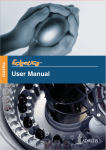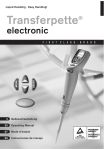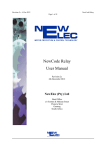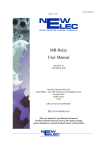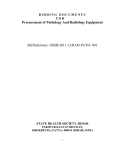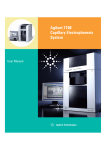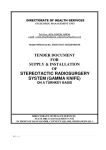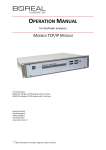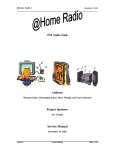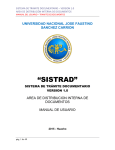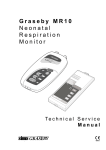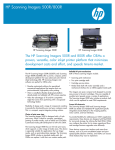Download ImaGo user manual. - Isogen Life Science
Transcript
User manual The new Multi-purpose Compact Imaging System 1-10-2001 (Software version 2.03) B&L Systems Industrieweg 68 3606 AS Maarssen (+31) 346-550556 the Netherlands -1- Index Introduction 5 Specifications 6 Safety Considerations 7 Installation 9 Basic operation 10 Electronic image positioning. 10 Electronic optical zooming 11 Additional operating information 11 Reference chart and function description 13 Auto. Exposure 14 Data dump 14 Contrast 15 Brightness 16 Magnify 17 Setup 18 Username 18 Password 18 Show overexposed pixels 18 Set auto exp. image 19 JPEG quality 19 Dump mode 19 Last printout # 19 Baudrate 20 -2- Printout with dump 20 UV-Top 20 Machine name 20 Exit the setup 21 Matching monitor and printer 22 Changing the print format 22 Changing the emission filters 22 Produce sharp images 22 Standard available emission filters 23 Available illumination cassettes 23 Available Top illumination 23 Data archiving 24 Applications 26 Staining of ds and ss DNA and RNA in gels 26 Experimental information for Ethidium Bromide 27 Useful tips for Ethidium Bromide 28 Experimental information for SYBR Gold 28 Useful tips for SYBR Gold 31 Staining of proteins in 1-D & 2-D Gels 31 Experimental information for SYPRO-Orange 32 Useful tips for SYPRO-Orange 33 Detection of proteins or DNA on membranes with ECF. 34 Protein detection. 35 The chemifluorescence advantage: 35 Experimental information for Attophos ECF substrate 36 Useful tips for Attophos 37 Trouble Shooting 38 Warranty 38 Maintenance 39 -3- Declaration of conformity 40 -4- This document is subject to confidential approach and information additional to the European standardized A form declaration. None of this document’s information may be copied or reproduced, as a hole or in part, in any way without written consent of B&L Systems. Introduction Congratulation with the purchase of your new ImaGo imaging system. The ImaGo is a state of the art digital imaging system designed for instant photography, computerized image investigation for gels, blots and other samples. Due to the unique optical design, the ImaGo is extremely small and suitable for a wide variety of applications. There is no need for manual positioning the sample after it has been put in the instrument because of the four positioning keys which permits the user to move the image in all directions. An electronic optical zooming can magnify your image to accommodate all sample sizes. The use of easy to change illumination cassettes allows multiple fluorophores to be excited. There is no need to make any adjustments on the optical components. On the photoquality printouts all active parameters are printed for GLP use. -5- Specifications Exposure time (integrating): Image freezing: Automatic exposure time Contrast setting: Image inverting: Brightness (Hi / Lo): Bottom illumination: Electronic optical zooming: Digital magnification: Image sensing: Reset to defaults: Screensaver: Printout: Data output: Filetype: Used paper: Image size (std) Sensitivity: Monitor: Main: Outer dimensions: Weight: 0.001 to 20 sec. Yes Yes -9 to +9 (18 curve types) Yes 0 to 100% Standard 302 nm. 20 x 25 cm. with automatic switch-off (10 min.) 6x 1-4x ImaGo 500: DSP controlled CCD camera 748 x 655 pixels. ImaGo 1200: DSP controlled CCD camera 1264 x 1024 pixels. Yes After 10 minutes no keyboard activities On build in photoquality thermal printer with GLP information. High-speed RS232C and High resolution video. (optional TCP/IP) JPEG 1-100% K61B (normal) or K65HM (glossy) 20 x 25 cm. to 3,4 x 4,2 cm. < 0.0005 Lux. High resolution build in with dark clamping. 210 to 240 Volt AC 50-60 Hz 180 Watt max. Installation Cat. II 520 x 380 x 500 (W-H-D) 49 kg. -6- Safety Considerations To ensure operation safety, this instrument must be operated correctly and maintained regularly. Carefully read to fully understand all safety precautions in this manual before operating the instrument. This manual denotes precautions against actions that can result in hazardous situations or equipment damage by using the signal words WARNING, CAUTION, and Note. Instruction manual symbol. If the product is marked with this symbol, refer to the instrument manuals to protect the instrument against damage. WARNING A WARNING indicates a potentially hazardous situation which, if not avoided, could result in death or serious injury . CAUTION A CAUTION indicates a potentially hazardous situation which, if not avoided, may result in minor or moderate injury. It may also be used to alert against unsafe practices. Do not proceed beyond a WARNING or CAUTION notice until you understand the hazardous conditions and have taken the appropriate steps. Note A Note provides additional information to aid the operator in obtaining optimal instrument performance. -7- Warning Label Warning labels are attached at several locations on this instrument. Do not remove, deface or damage the warning labels. If a warning label peels off the instrument or becomes illegible, contact your local ImaGo distributor for a replacement label. Warning for FUSE Only use fuses of the designated rating to protect both operator and instrument from fire and other hazards. The warning labels that pertain to fuse ratings are located on the back panel of the instrument and inside near the fuses. -8- Installation Unpacking and placing the instrument 1. Unpack the instrument by opening the box and take out all separate boxes. 2. Takeout the instrument of the box and directly place it on top of the bench. It is recommended to level the instrument because the sample can float on top off the illumination cassette. This will result in an unsharp image 3. Take care that there is minimal 10cm. distance between backside of the instrument and the wall. It is advisable to keep some more space on the right hand side because of the better accessibility of the camera-hatch. WARNING The ImaGo must be connected to a main outlet 220VAC 50Hz. with grounding. 4. Unpack the illumination source (standard 302 nm.) 5. Remove the drawer-lock which prevent the drawer to open during transportation. 6. Open the drawer and place the illumination cassette in the drawer and carefully but firmly press it against the backside of the drawer. If the cassette is correctly inserted, a click can be heard. 7. Remove the transportation screw on the right-hand side to unlock the camera driving- system. WARNING If locking the camera is needed for renewe transportation, be carefull not to overtighten the transportation scrw. It meight harm the camera unit. 8. Open the printer front with the small bar on the left-hand side of the printer. 9. Insert the printer paper as indicated on the label inside. 10. Close the printer front. 11. Switch on the ImaGo with the main switch located at the back of the instrument 12. If needed adjust sharpness (see ‘Operating the ImaGo’) Your ImaGo is now ready for use!! -9- Basic operation After the instrument is switched on the ImaGo logo will appear. To continue, press Func., +, -, Enter or print. If no key is pressed the software willautomatically after 10 seconds continue with normal operation. Keyboard layout Step 1: Open the drawer and place your sample on the ilumination cassette. Step 2: Close the drawer and switch on the appropriate illumination source. Step 3. Adjust the exposure-time for a good visable image. (zoomed out) Step 4. Position your image with the arrow keys in such a way it fills the whole screen. This in combination with the ZOOM keys. Step 5. Press Enter key to freeze the image. Step 6. If wanted adjust image and make a printout by pressing Print. Electronic image positioning. One of the unique features of the ImaGo is the electronic image positioning. This can simply be accompliced using the arrow keys. It means you only have to take care your sample is alligned in horizontal position and you do not have to take care where it is on the illumination cassette. It is also possible to image the sides of the sample and zoom-in for a detailed view. The sample remains at its initial place, only the viewing position is chanced. - 10 - Electronic optical zooming This feature allows you to zoom-in and zoom-out with full optical resolution. The maximum zooming range is 6 x. This means a viewing range from 4,7 x 3,5 cm. to 28 x 20 cm. Additional operating information After placing your sample on the illumination cassette you have to switch on the source. This can be the TOP-light (standard is white) or the BOTTOM-light (illumination cassette). The keys are named accordingly. A LED next to the key will illuminate if the illumination is switched on. If the drawer is not closed, the bottom-light will be off, even if the keyboard LED indicates it is on. To bypass this safety switch simply pull the white knob at the left top of the drawer hole. This function enables you to cut fragments with the drawer opened. Note: If the illumination source is not properly pressed towards the back of the drawer (hear the click!) it will not operate as well. WARNING UV radiation can be harmful. Wear eye protection if used in this way. In normal acquisition mode, no functions are available. You can only change the exposure time with the + and – keys. Image positioning, zoom and illumination keys remain active. The ‘live’ image is always an unprocessed picture. This to be sure that the widest dynamic range can be used. Image positioning can easily be done with the arrow keys. If you would like to zoom a specific part of your sample you can do so with the ZOOM-IN and ZOOM-OUT keys. Note: The bottom illumination cassette will switch off automatically after 10 min. If the image is frozen the light source can be switched off. This is advisable to prevent the sample from denaturation. The information on the monitor will change and indicate the active function. The image will be processed according to the latest used parameters. Pressing the Func. key will change to the next function. The Print key is only active if the image is frozen!! - 11 - After selecting the desired function, the monitor will indicate the chosen function in the statusbar (bottom of the screen). Note: To escape from any point in the menus, to the acquisition mode, press Func. key and then Enter key, while keeping the Func. key pressed. (Not valid for setup mode) Note: If the screen is dark due to the screen saver, press Func., +, -, or Enter to restore the screen. (no key-function operation is performed) - 12 - Reference chart and function description Function Key + / - range Enter key function Manual Exposure (mode=live) 0.001 – 20 sec. Freeze / Live Manual Exposure (mode=frozen) Auto Exposure Data Contrast Brightness Magnify Setup -9 to +9 0 to 100% 1x to 4x Start detection Dump image Invert (toggle) Hi / Lo Reset to defaults Enter setup Note: To return from one of the above functions to image acquisition (live) press Func. and Enter keys simultaniously. Manual Exposure (mode = live) The exposure time is the time used to acquire the image from your sample. If faint bands or spots are not visable, raise the exposure time. If the image becomes saturated (to white for fluorescence) lower the exposure time. The image is updated after every exposure. The exposure time can be set from 0.001 to 20 sec. For Ethidium Bromide stained gels an often used exposure time is +/- 0.5 sec. Pressing Enter will freeze the image and all other functions will be available. The statusbar at the bottom of the image will change and show all parameters used including the functionality of the active control keys. Note: In this mode the Print key is not active! Manual Exposure (mode = frozen) From this point on you can print an image just by pressing the Print key. This can be done from all functions except during setup. Pressing Enter in this mode returns to the image acquisition mode (live) again. - 13 - Auto. Exposure The Auto Exposure function enables you to detect the optimal exposure time. The function will automatically adjust the exposuretime based upon the image rectangle defined in the setup. (see setup function) After detection the ImaGo will switch over to manual exposure (mode=live). This to have the possibility to readjust the exposure time manually. Data dump If selected, pressing the Enter key will cause the image to be transferred to the connected Windows based computer. Transfer is made over the RS-232C interface. Optional a direct image transfer over UTP network is available. In the setup function a selection can be made if a printout is made parallel to the data dump. This ensures to have the image and printout exactly the same. - 14 - Contrast This function will change the contrast of the image. There are 18 different curves available to change the black- and white distribution as indicated in figure 1. The Enter key will toggle between normal and inverse image Inverted image Contrast curves (fig 1) Output gray level Contrast setting Input gray level Two examples of the contrast setting: Contrast –9 Contrast +9 - 15 - Brightness The brightness settings contains two parameters. The upper and lower limits are called Hi and Lo. Toggle between these two parameters is done by pressing the Enter key. The value is a percentage of the total image black-to-white range. e.g. black is 0% and full white is 100%. Example: Lo=25 and Hi=85 This means that pixel intensities below 25% will remain black. The pixel intensities above 85% will all be at maximal white. So the remaining 25% to 85% will be stretched to a visable range from 0% to 100% Increasing the Lo value will subtract background. Decreasing the Hi value will show faint bands or spot more bright. 100% Original Pixel Intensity New pixel intensity streched to a range from 0 to 100% 0% Note: It may take up to 1,5 seconds before the image is fully processed if the Lo or Hi values are changed. - 16 - Magnify Digital magnification can be selected in the range from 1 to 4 times. Magnification is always calculated from the image centre. Original 3 times magnified Reset to defaults (within magnify function) The Enter key will reset all the image process functions to the default values. These are defined in the setup function. The exposure time is also set to the default but this is only visible at the first new ‘live’ image. - 17 - Setup In the setup function system parameters and default values can be stored. The parameters are: Exposure time Contrast Inverse / normal image Brightnes Hi and Lo Magnification Password Note: The values stored to defaults are the values active at the moment you enter the setup function. Note: Shorthand information is available in the status bar at the bottom of the screen. Select the function and press Enter. The image disappears and the password ‘BLS’ can be entered. If an extra password is defined in the setup, this one can be used as wll. During the input of the password the characters are readable. Characters can be selected with the + and – keys followed by the Enter key. Pressing the Enter key can skip unused characters. Choose one of the 11 parameters by pressing the + or – keys. Username (8 characters) This name is printed in the left bottom on the printout and data dumped image for identification purpose. Normally this is the name of the department or the laboratory. Password (8 characters) This function permits the input of an extra password to be used to enter the ‘setup’ The factory password ‘BLS’ remains active. Show overexposed pixels (on / off) If quantification of bands or spots is required they may not be overexposed. The highest concentration (lightest band or spot) should be within the dynamic range of the camera. If this parameter is set to ‘on’ by pressening the Enter key than all pixels which have an intensity above 99.5% will start blinking. (image should be frozen) - 18 - The blinking is an indication for the user only and is not visible on the printout and / or data dump. Set auto exp. image (area) Selecting this parameter followed by Enter will show the last image in memory with a rectangle super imposed in white. With the + / - keys you can change the size of this rectangle. The active area (inside the rectangle) will be the part of the image, which is used to automatically calculate the exposure time. (See Auto exposure function) If the area is adjusted, press Func. to return to main setup screen. JPEG quality (5-99%) The data dump is the transfer of an image via the RS-232C interface. For saving transfer time the image is compressed. The compression used by the ImaGo is JPEG. As a standard 50 is chosen which is right for almost all applications. Increasing this value will increase the file size and transfer time but decreases the image alteration. It is not recommended to change this parameter. If the new value is entered by using the + /- keys press Func. to return to main setup screen. Dump mode (ASCII / binary) If ‘ASCII’ is selected the data transfer is in full readable ASCII characters else the binary function is selected and the image data in binairy format. The output file has the format: Image output starts with: ‘*’ Followed by the Image number (7 ASCII characters) Followed by a ‘*’ Image data (ASCII or binary) End of file character Example: *000025* filedata EOF The ImaComm software will store these data in different image formats again on the PC. See for further explanation the chapter ‘ImaComm data archeiving’ Last printout # (0-999999) The image number is updated automatically after every printout and / or data dump. If a upload of new firmware is carried out the image number is set to ‘0’ - 19 - It is possible to enter the old image number. The highest number is 999999. Overflow will result in reset to ‘0’ Baudrate (9600, 19200, 38400, 57600, 115200) This number indicates the transmission speed of the RS-232C port of the ImaGo. Normally it is set to ‘115200’. If the network transfer unit is used it is prefered to use ‘57600’. The maximum RS-232C cable length at 115200 baud is 5 meter. Lowering the baudrate will increase the maximum cable length used for the image transfer. Printout with dump (on / off) If ‘on’ a printout will be generated at the same time a data dump is made. This ensures that PC-data and printout are identical. UV-Top (Not installed / installed) If the UV toplight option is installed it can be switched on by selecting both the Topand bottom light. In this case ‘UV-Top’ will be printed / dumped as illumination source. Machine name (ImaGo / LumaGo) The ImaGo can optionally be equipped with a luminescence unit. In this case the ImaGo will be renamed as ‘LumaGo’. It only effects the name on the printout / datadump. At the bottom the setup screen a test bar is shown which changes from black to white and visa versa. The can be used to match the printer and monitor. - 20 - Exit the setup To exit the setup press Func. From here you have to chose Yes or No. Yes means that all values are permanantly stored in the ImaGo. After switch ‘off’ and ‘on’ the ImaGo the values will still be active. If answered with no the values are valid but only until the ImaGo is switch off. - 21 - Matching monitor and printer If you have entered the setup mode, you will see a testbar at the bottom of the monitor. It starts at 0% (black) and goes linear to 100% (white) and back again. To be sure that the printer is producing the same printout as what you see on the monitor (WYSIWIG) you press the Print key on the printer itself to produce a printout. Normally the matching is done at the factory but over time readjustment may be necessary. Refer to printer manual to change these parameters. Printer factory settings: Brightness: Contrast: Printsize: Gamma: 6.0 c.0 SN R5 Changing the print format The printer in the ImaGo can produce several printout formats. The procedure is clearly written in the manual supplied with the printer. Changing the emission filters To change the emission filter, slide down the cover on the right-hand side. The lens will be visible. Unscrew the filter while keeping the lens adjustment in its place. Mount the new filter in reverse order. Follow the next procedure to adjust the sharpness of the image. Produce sharp images If image is not sharp than put a testjig on the illumination cassette and switch on the top-light. Take care that the diaphragm (lowest ring of the lens) is locked on 3.0 (not 1.0). Adjust the brightness of the image by changing the exposure time. (Normally around 0.3 sec.). Fully zoom-out and adjust the upper ring of the lens to get the best image (distance). After this, fully zoom-in and readjust (fine-adjustment). - 22 - Standard available emission filters Wavelength (nm. / BW) 600 / 100 530 / 40 560 / 40 (high sens. As standard) (e.g. Sybr. Green) (e.g. ECF) Note: Others in the range of 450 to 700nm. on request! Available illumination cassettes Wavelength (nm.) 256 302 (As standard supplied) 365 460 520 ImaVex 8 user definable wavelengths in the range of 400 – 700 nm. Dual wavelength excitation. Permits detection of fluorophores with a stokeshift > 15 nm. Available Top illumination Wavelength (nm.) 256 302 365 450 - 23 - Data archiving Image archieving can be carried out by using the ImaComm archiving software. This is a standard supplied package and should be installed on a Windows 95, 98, NT or 2000 platform. Installation in done by starting ‘setup’ from disk one. Follow the instructions on the screen during the installation. Fig. 1 shows the normal screen if the program is started. Note that this software will run in ‘background’ so it will not prevent you working on your PC Fig. 1. Fig. 2 Shows the setup which should be filled in to ensure the images are stored in the right format, in the right directory. Additional information is given on the screen. Fig. 2. - 24 - Fig. 3 shows the communication parameters. All should be according these setting. The only exception is the communication port number that should be the same as the one on which the ImaGo is connected to. Only change this if needed Fig. 3. - 25 - Applications Staining of ds and ss DNA and RNA in gels Fluorescent Dye’s applicable for the ImaGo are Ethidium Bromide, SYBR Green, SYBR Gold Technical applications: Gel Shift Assay AFLP (Amplified Fragment Length Polymorphisms) Heteroduplexing MVR (Multiple Variable Repeats) Purity checking of DNA prior to sequencing RT PCR quantitation (Reverse Transcriptase PCR) STR (Short Tandem Repeats) mRNA differential display RNA quantitation SSCP (Single Stranded Conformational Polymorphisms) DNA quantitation Technical Background: RFLP The human genome contains a wide variety of DNA sequences that are present in multiple copies. The exact number of copies of each repeated sequence varies with each individual. RFLP is a technique for looking at the variation in the copy number of these repeats by cutting genomic DNA with specific restriction nucleases, separating them on an agarose gel and then hybridizing probes specific for different repeated sequences. The information obtained can then be used for identification purposes. AFLP (Amplified Fragment Length Polymorphism) Similar to RFLP, the difference is in the way the fragments are produced. In RFLP, regions of repetitive genomic DNA - 26 - are lit up with a probe after all the DNA has been cut into small pieces by a restriction enzyme. In AFLP, the fragments are produced by PCR amplification using unique sequences that flank the repetitive region. Again, since each one of us has a particular repetitive set of regions, which contain a variable number of repeats, individuals can be identified by the size of the different fragments. The advantage of AFLP over RFLP is that less material is needed to identify the individual. SSCP (Single Stranded Conformational Polymorphism) Unlike Southern blot analysis, SSCP relies on the migration characteristics of single stranded DNA, which is very dynamic in its kinetic action This structure allows it to either migrate faster or slower through a gel. Some researchers rely on this technique to give them information about single base substitutions that are known to be associated with disease. Experimental information for Ethidium Bromide Advantages: Easy, inexpensive to use Detects 2 ng/band dsDNA in agarose or acrylamide, including denaturing gels Detects ~100 ng/band RNA in non-denaturing agarose gels Greater dynamic range on the ImaGo system than Polaroid film Rapid quantitative analysis using the Intelligent Quantifier software. Excitation Maximum: 302nm Emission Maximum: 615nm Post-Staining: Run gel. Stain for at least 20 minutes in 0.5 micrograms/ml EtBr in water, TE or TBE on a shaker. Destain for 20 minutes in water Pre-casting : Cast gel using a final concentration of 0.5 micrograms/ml EtBr. Run gel using 0.5 micrograms/ml EtBr in running buffer. Destain for 20 minutes in water (optional) TE, TAE or water can be used to make up the 0.5 micrograms/ml EtBr stock solution. Binding: EtBr is a non-covalent intercalating dye. Detection Limits: Detection of ssDNA and RNA is less sensitive than for dsDNA. Exact figures for ssDNA are not currently available. Sensitivity will always be better in acrylamide gels than in agarose gels because acrylamide gels have lower background. Sensitivity: 2 ng dsDNA/band, depending on fragment size. ~100 ng RNA/band in non-denaturing gels. Larger fragments will bind more EtBr. Linear Range: ~1.5 orders of magnitude. Emission Filters: Ethidium Bromide filter - 27 - Useful tips for Ethidium Bromide Binding efficiency and sensitivity of EtBr with ssDNA and RNA is less than with dsDNA. EtBr and SYBR™ Green I compete for DNA binding. Staining first with EtBr, then with SYBR Green I will give better results than with EtBr alone, but inferior to pure SYBR Green I staining. For use in agarose and polyacrylamide gels. To stain denaturing gels, wash gel to remove urea before staining. Longer stain times do not improve sensitivity. However, when dealing with highly concentrated, tightly packed bands in a high percentage gel, allow more time for the EtBr to penetrate further into the bands to improve visualization. Staining and/or destaining for less than 20 minutes is not advised. Destaining longer than 20 minutes can decrease band signal strength. Pre-casting gels with EtBr can save time after electrophoresis, but may also alter migration of fragments. EtBr migration causes non-uniform background staining in pre-cast gels. Post-staining should be used for quantitative analysis. Store dye solution covered with aluminum foil to prevent bleaching of fluorophore by overhead lighting. Stain solution can be re-used when stored at 4 degrees C, but must be strengthened by addition of fresh EtBr stock solution to compensate for that taken out of solution by the staining of previous gels. Diluted stain solution will keep up to one month at 4 degrees C. It is not advisable to do either restriction digests or blotting after EtBr-staining. CAUTION Use gloves due to mutagenicity. Powder can be stored at room temperature but must be protected from light. In aqueous form, the stain should be stored at 4 degrees C protected from light. Use gloves due to mutagenicity. Experimental information for SYBR Gold Advantages: More sensitive than EtBr Allows post-stain processing of DNA, e.g., restriction digest or Southern blotting Replaces silver staining and radioactive labeling in some applications, e.g., SSCP Can be used with glyoxal and formaldehyde gels Quick quantitative analysis using the Intelligent Quantifier software SYBR gold can be used in the presence of urea, glyoxal and formaldehyde. No need to destain because of low background. Allows excision of bands for cloning after heteroduplexing. Excitation Maximum: 300 nm Emission Maximum: 537 nm - 28 - Post-Staining: Run gel. Use centrifuge to spin stock solution to bottom of tube. Dilute SYBR Gold to a final dilution of 1:10,000 in TE, TBE, or TAE (pH 7.0-8.5). Leave gel to shake in dye solution for 10-30 minutes, longer for thicker or higher percentage gels. No destaining step necessary. Pre-Staining: Incubate DNA with 1:5,000 SYBR gold for 15 minutes, prior to electrophoresis. Add loading dye after 15 minute incubation. Pre-casting: (Preferred method for high percentage gels) Dilute SYBR Gold to 1:10,000 into gel solution just prior to casting. Add 1:10,000 dilution of SYBR Gold to running buffer. Binding: SYBR Gold is thought to bind non-covalently to the phosphate backbone of the DNA molecule. Detection Limits: Post-staining: Pre-staining: Linear Range: Emission Filters: Detection of ssDNA and RNA is less sensitive than for dsDNA. Exact figures for ssDNA are not currently available. Sensitivity will always be better in acrylamide gels than in agarose gels because acrylamide gels have lower background. in acrylamide: ~100 pg dsDNA/band depending on band size, 1-3 ng ssDNA or RNA, 10-20 ng synthetic 24-mer oligonucleotide. ~400 pg in 0.8% agarose ~150 pg in 6% acrylamide ~450 pg in 0.8% agarose ~1.5-2 orders of magnitude. SYBR gold filter - 29 - - 30 - Useful tips for SYBR Gold Use double-gloved protection against DMSO stock solution. Cover dye solution with aluminum foil to prevent bleaching of fluorophore by overhead lighting. SYBR Gold and EtBr may compete for DNA binding. Staining first with EtBr, then with SYBR Gold will give better results than with EtBr alone, but inferior to pure SYBR Gold staining. Avoid use of bind silane with SYBR Gold on polyacrylamide gels; it is preferable to use a Gel-Slick-type product on the opposite plate. Staining of extra large sandwich gels can be easily accomplished by laying the gel sandwich onto paper towels, having cleaned the glass plates well first. Remove top glass plate then pipette enough 1:10,000 SYBR Gold stain onto gel to cover completely. Spread evenly with Pasteur pipette and leave protected from light for 1060 minutes. If required, SYBR Gold can be removed from dsDNA by simple ethanol precipitation. Bring solution up to 10Mm NaCl, add 2.5 volumes 95% ethanol, incubate 20 minutes on ice, centrifuge for 10 min at 4C. Storage: In DMSO in plastic, protected from light. Stock solution kept at -20 degrees C is stable for six to twelve months. Diluted reagent kept at 4 degrees C is stable for three to four days. Handling: Treat as potential mutagen, as data is unavailable. Vendor: Molecular Probes, Inc. www.probes.com Staining of proteins in 1-D & 2-D Gels Fluorescent and non-fluorescent dye’s applicable for the ImaGo: SYPRO-Orange, Coomassie blue, copper, zinc, and silver stain. Technical applications: 1-D protein electroforesis. 2-D protein electroforesis Proteomic analysis Western blot analysis - 31 - Experimental information for SYPRO-Orange Advantages: Simple, quick staining protocol. As sensitive as silver staining (~2ng/band for most proteins). Linear range from 2ng to at least 1 microgram. Allows western transfer and immunodetection after staining. Nonspecific fluorescent staining of denatured proteins in 1D and 2D SDSpolyacrylamide gels. Excitation Maximum: 300 nm. Emission Maximum: 570 nm. Binding: Nonspecific, SDS-dependent binding to proteins. Detection Limits: As for all protein staining systems, dye binding will depend on the amino acid composition of the proteins. Proteins in native gels will exhibit more staining variability than proteins saturated with SDS. 56ng/band for most proteins in denaturing gels Run gel. Dilute SYPRO Orange 1:5000 in 7.5% acetic acid (enough to cover gel). Shake vigorously. Place gel and stain in a foil-covered container, and shake gently for 30-60 min. Optional: destain in 7.5% acetic acid for 10-15 min. Rinse briefly in distilled water. Alternative Protocol for Western Transfer. Dilute SYPRO Orange 1:5000 in Tris/Glycine/Methanol transfer buffer. Proceed with staining as above. If necessary, destain in transfer buffer. Linear Range: Emission Filters: Storage: 2 orders of magnitude. SYPRO-Orange filter Stock solution is stable for six months to one year stored at -20 degrees C and protected from light. Staining reagent diluted in buffer or 7.5% acetic acid can be stored protected from light at 4 degrees C for at least three months. - 32 - Handling: Vendor: No toxicity data available. Stock solution contains DMSO and should be handled with double gloves. Molecular Probes, Inc. www.probes.com Useful tips for SYPRO-Orange Ensure glass plates and staining containers are completely free of grease and fingerprints. Use powder-free gloves to handle gels. Mix staining solution fresh immediately before using. Shake staining solution vigorously before adding it to the gel. Staining in acetic acid significantly impairs immunodetection. For western blotting, stain in transfer buffer (sensitivity may be slightly diminished.) Staining solution can be reused effectively at least three times. When staining native gels, soak gels in 0.1% SDS (in either 7.5% acetic acid or water) for 30-60 min prior to staining. Sensitivity will be diminished in native gels. Methanol can adversely affect staining. To eliminate methanol, soak gel in 7.5% acetic acid for 1-2 days prior to staining. When staining acidic proteins, increase the concentration of SDS in the gel and buffers to 0.2%. - 33 - Detection of proteins or DNA on membranes with ECF. Chemifluorescent substrates applicable for the ImaGo: ECF Substrate (AttoPhos) Technical applications: Colony/plaque screening Dot/slot blots Human DNA quantitation (forensics) RFLP/VNTR Southern blotting Western blotting Colony Hybridization Plaque Lifts Technical Background: Chemifluorescence is the enzymatic conversion of a fluorogenic substrate to a fluorescent product. Fluorogenic compounds (non-fluorescent or weakly fluorescent substances that can be converted into fluorescent products) are available for use with a wide variety of enzymes. ECF reagent kits (Amersham Life Science) simplify chemifluorescence for membrane-based protein and nucleic acid detection. The kits use alkaline phosphatase, which cleaves a phosphate group from a fluorogenic substrate to yield a highly fluorescent product . Alkaline phosphatase and horseradish peroxidase are currently used interchangeably in most colorimetric and chemiluminescent membrane detection assays, including southern, northern, western, and slot or dot blotting. Chemifluorescence can be used in place of any standard chemiluminescent protocol simply by using an alkaline phosphatase conjugate and the chemifluorescent substrate. Standard buffers and incubations remain unchanged. After a short incubation with the substrate, image the blot on the ImaGo. The light source in the instrument excites the fluorescent - 34 - product, which emits light in a band centered around 560 nm. The instrument detects this fluorescent signal and creates a digital image of your sample. Genomic Solutions Intelligent Quantifier(TM) software allows rapid and accurate quantitation of the results. Protein detection. For protein detection using the Vistra ECF Western Blotting Kit on blots or microplates, the primary antibody is recognized by a secondary antibody that is conjugated to fluorescein. Amplify the signal by incubating the blot with the antifluorescein tertiary antibody conjugated to alkaline phosphatase, followed by the substrate. The substrate is cleaved by alkaline phosphatase to yield a fluorescent signal. The chemifluorescence advantage: 1. Specificity and versatility. Like chemiluminescence, chemifluorescence is based on the affinity binding of an enzyme-conjugated probe to the target molecule. Alkaline phosphatase is readily available conjugated to antibodies that target a wide variety of haptens, or to streptavidin. The use of antibodies ensures specific detection, while allowing great versatility in choice of target molecules for both protein and nucleic acid detection. 2. Signal amplification. Under the proper conditions, enzymes continue to convert substrate to product as long as the substrate is available. In chemifluorescence, each alkaline phosphatase conjugate can generate many fluorochrome molecules, continually increasing the signal at any given target. For many samples, only a few seconds of incubation with the substrate yields sufficient signal. However, blots can be incubated for as long as 24 hours to maximize the signal from low-abundance targets. 3. Nondestructive imaging and adjustable sensitivity. Unique advantages of chemifluorescence are that imaging a fluorescent blot on a ImaGo fluorescence imaging system is nondestructive, requires no film exposure, and takes only a few seconds. If an initial image is either weak or saturated, adjust the sensitivity of the detection system to maximize the signal over background and then reimage, or continue incubation with the substrate to develop additional signal. With nondestructive imaging and adjustable sensitivity, you can achieve the best results possible for each experiment. 4. Stability. In fluorescence, light emission occurs only during exposure to the excitation light (i.e., within approximately 10 nsec of absorption), but a single fluorochrome molecule - 35 - can be excited repeatedly and can emit light each time. Many fluorochromes are stable for a long time. Fluorescent probes can be kept for many months, and a fluorescent blot can be stored and reimaged after several weeks with little decay in signal. In contrast, a chemiluminescent molecule is autonomously luminous. No excitation light is required for chemiluminescence, however the luminescence peaks within minutes of substrate addition and decays over just a few hours. 5. Limits of detection. For most blotting applications, the limit of detection of chemifluorescence is equal to that of chemiluminescence, and is better than that of colorimetric detection. 6. Established protocols. Chemifluorescence uses the same labeling protocols as chemiluminescence. A chemiluminescence system that already uses alkaline phosphatase can become a chemifluorescent system simply by switching to the chemifluorescent substrate. For a system using horseradish peroxidase (HRP), just replace the HRP conjugate with an analogous alkaline phosphatase conjugate, and incubate with the chemifluorescent substrate. Standard buffers and incubations remain the same. 7. Quantitation. Chemiluminescence is linear over about a tenfold range. In an analogous system, chemifluorescence is linear over about a 50-fold range. Experimental information for Attophos ECF substrate Advantages: Comparable sensitivity to chemiluminescence Eliminates the need for dark room, film and chemiluminescent screens Greater dynamic range than film allows visualization and quantitation of weak and dark bands in the same image. Substrate for alkaline phosphatase. Converts by enzymatic reaction to fluorescent product, which emits light when excited by a suitable excitation light source. Alkaline phosphatase-linked secondary antibodies and ECF substrate can be used to amplify signal detection in a variety of microplate and membrane-based applications, such as southern, northern, western, dot and slot blots. No probe purification step necessary. Probes stable at least six months at -20 degrees C. Excitation Maximum: 440 nm Emission Maximum: 560 nm Buffer: 2.4M diethanolamine (DEA) in water. 0.23mM MgCl2. pH 10.0 using NaOH. Buffer is stable for one year when stored at 4 degrees C Method: Use 1mM ECF Substrate dissolved in buffer, or use kitconcentration. For all procedures, including Southerns, westerns and northerns, use clean containers, pipette tips etc. and pipet ECF Substrate onto a - 36 - overhead projector sheet and lay blot face down onto solution. Be sure to coat blot completely and evenly with substrate. Incubate as needed, then transfer blot face down to imaging surface. Always image immediately in case of rapid signal development, then every 15 minutes up to one hour, then every hour, leaving overnight, if necessary. For western blots on PVDF membranes, blots can be scanned either wet or dry. Binding: ECF Substrate is dephosphorylated to the fluorescent product, which remains in the region in which it is produced. It is believed to adhere to the membrane by charge interactions. Detection Limits: Variable depending on the application. 10-10 M of product can be detected in a microplate well. Linear Range: application). ~1-3 orders of magnitude (highly variable depending on Emission Filters: Attophos filter Storage: In clean glass or plastic, refrigerated and protected from light. In buffer (2.4M DEA, pH 10.0, 0.23mM MgCl2) Diluted reagent at 4 degrees C keeps up to one week. Handling: Use powder-free gloves to protect ECF Substrate from naturally occurring alkaline phosphatase on hands. Vendor: Amersham Life Science Inc. Useful tips for Attophos Always image immediately. Some blots can develop within minutes. Use of water between imaging tableglass and plastic bag reduces optical refraction and results in a clearer image. Use Mylar rather than Saran wrap as a cover. It is far less fluorescent. Covered refrigerated solution can be used up to one month. Use of containers and tips cleaned by sterilizing or by rinsing with 0.01M HCl or boiling water reduces background resulting from ambient alkaline phosphatase. Autoclaving of blocking solution and filtering of reagents can decrease background from ambient alkaline phosphatase. Use of powder-free gloves is important, as the powder fluoresces. - 37 - Trouble Shooting No operation at all Power LED on but no image Zooming not functioning No image positioning possible in vertical direction. No image positioning possible in horizontal direction. Image is not sharp over the entire zooming range. Illumination sources are not functioning but LED’s switches on /off. ImaGo seems to operate normally but no sample results are obtained even these can be observed by eye. Check fuses at the main entry. If needed, replace both (for 110V – 2A or 230V – 1A) Check if TOP light operates. If still no image, check diaphragm and zoom out fully. If still no image check fuses on main board. Check functioning of zooming at lens itself. If zoom motor turns, check rubber wheel. Check if camera is moving when cursors are pressed. If not, call service. Check if moving mirror turn (very little) if cursors are pressed. If not call service. Lens is misaligned. Call service for procedure. Check if illumination cassette is properly inserted in the drawer. Check fuses at the mainboard. Check emission filter (on lens) Fully zoom out and check again. Warranty The ImaGo is supplied with a full year warranty. Warranty does not cover the illumination cassette-filter and lamps, the top light source and the emission filter. Warranty is void if instrument is serviced by unautherised personnel. B & L Systems can not take any responsibility for the functioning of the ImaGo or its safety if the instrument is not properly handled. - 38 - Maintenance The ImaGo is designed to operate with a minimum of maintenance. Despite the closed construction it may appear that the emission filter on top of the lens and sometimes the movable mirror above the lens has to be cleaned. This is only due to the touching of these components by hand. Cleaning can easily be done with ethanol/water (50/50%). Take care not to scratch the surfaces. After cleaning take care that the lens is focussed properly WARNING Cleaning the lens should only be done with a soft optical cloth. - 39 - Declaration of conformity B&L Systems herewith confirm that the below mentionned products are fully tested and have been approved for all applicable safety rules. (EN 61326-1 classe B, and EN 61010) It is therefore that we certify these products with the CE marking. Products: - ImaGo 500-MZ, ImaGo 1200-MZ - All supplied illumination cassettes 15th April 2000 B & L Systems The Netherlands H. Beijersbergen van Henegouwen Director. - 40 -








































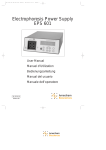
![hl-2-1300p_2007-12(7) [igg ief].qxp](http://vs1.manualzilla.com/store/data/006137619_1-26e8762877f1faf64ab49404d6bc071f-150x150.png)


